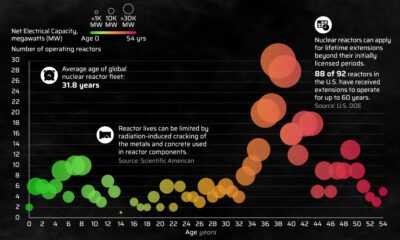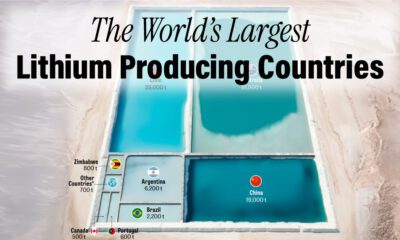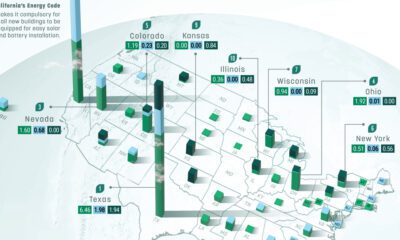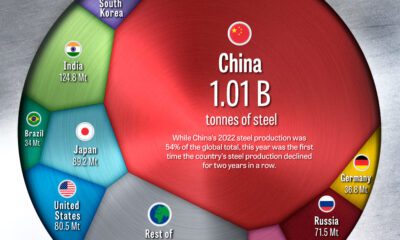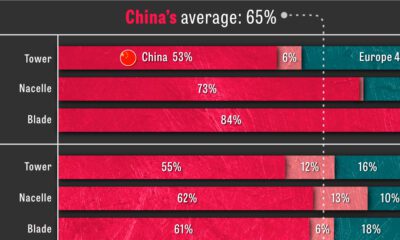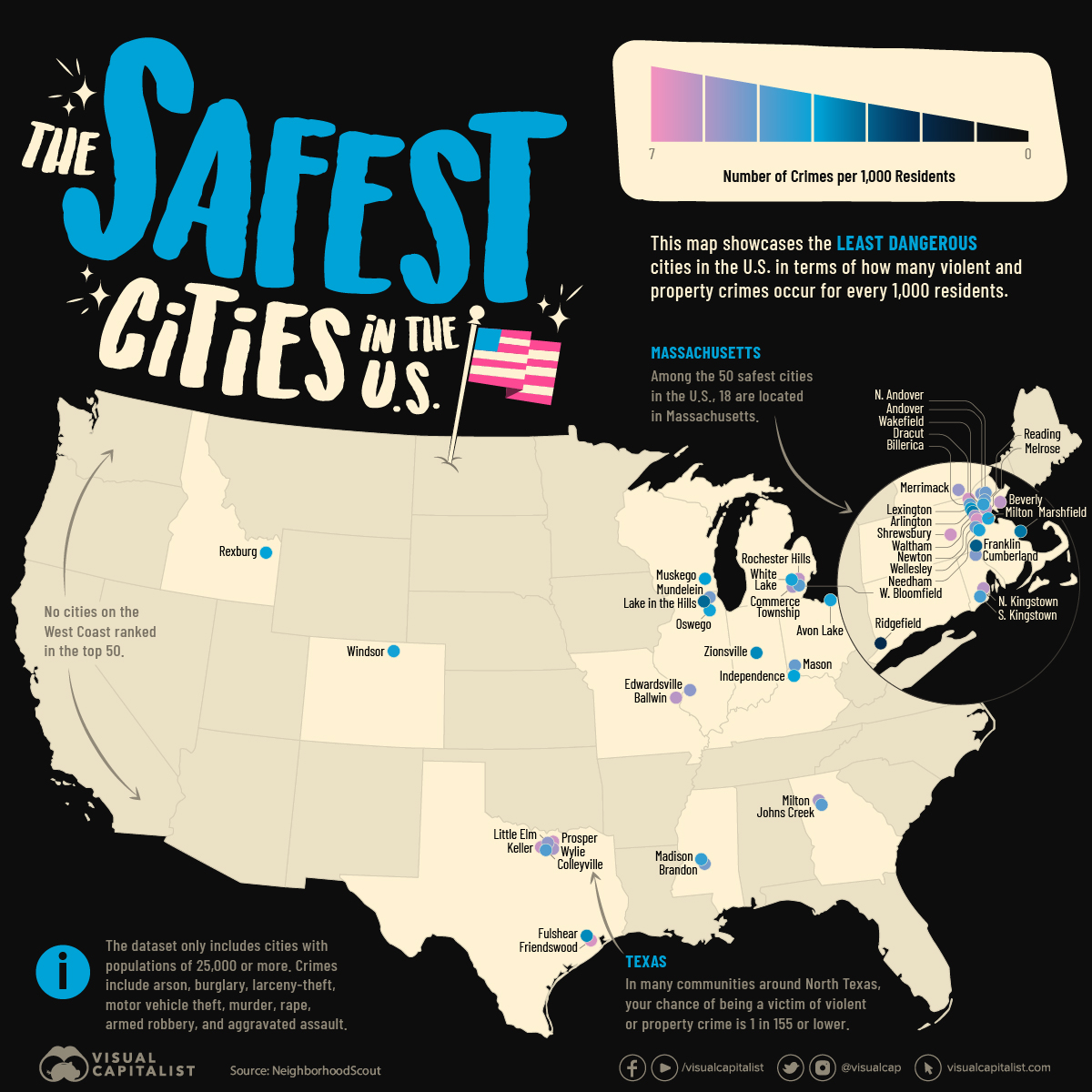Maps
Visualizing the Uranium Mining Industry in 3 Charts
When uranium was discovered in 1789 by Martin Heinrich Klaproth, it’s likely the German chemist didn’t know how important the element would become to human life.
Used minimally in glazing and ceramics, uranium was originally mined as a byproduct of producing radium until the late 1930s. However, the discovery of nuclear fission, and the potential promise of nuclear power, changed everything.
What’s the current state of the uranium mining industry? This series of charts from Truman Du highlights production and the use of uranium using 2021 data from the World Nuclear Association (WNA) and Our World in Data.
Who are the Biggest Uranium Miners in the World?
Most of the world’s biggest uranium suppliers are based in countries with the largest uranium deposits, like Australia, Kazakhstan, and Canada.
The largest of these companies is Kazatomprom, a Kazakhstani state-owned company that produced 25% of the world’s new uranium supply in 2021.
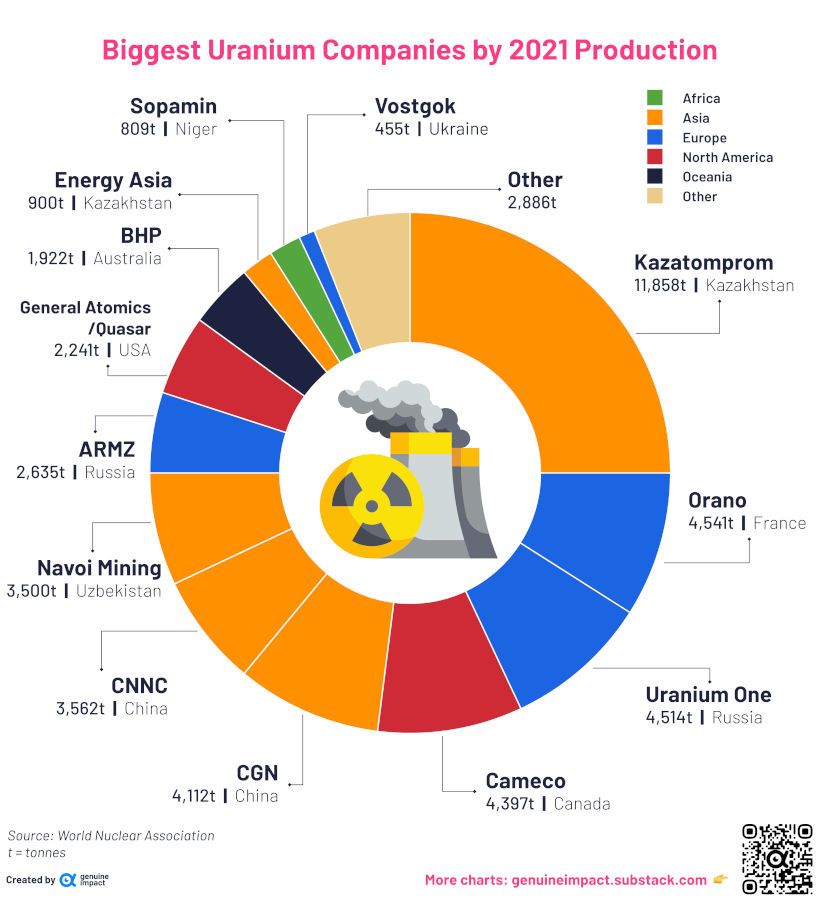
As seen in the above chart, 94% of the roughly 48,000 tonnes of uranium mined globally in 2021 came from just 13 companies.
| Rank | Company | 2021 Uranium Production (tonnes) | Percent of Total |
|---|---|---|---|
| 1 | 🇰🇿 Kazatomprom | 11,858 | 25% |
| 2 | 🇫🇷 Orano | 4,541 | 9% |
| 3 | 🇷🇺 Uranium One | 4,514 | 9% |
| 4 | 🇨🇦 Cameco | 4,397 | 9% |
| 5 | 🇨🇳 CGN | 4,112 | 9% |
| 6 | 🇺🇿 Navoi Mining | 3,500 | 7% |
| 7 | 🇨🇳 CNNC | 3,562 | 7% |
| 8 | 🇷🇺 ARMZ | 2,635 | 5% |
| 9 | 🇦🇺 General Atomics/Quasar | 2,241 | 5% |
| 10 | 🇦🇺 BHP | 1,922 | 4% |
| 11 | 🇬🇧 Energy Asia | 900 | 2% |
| 12 | 🇳🇪 Sopamin | 809 | 2% |
| 13 | 🇺🇦 VostGok | 455 | 1% |
| 14 | Other | 2,886 | 6% |
| Total | 48,332 | 100% |
France’s Orano, another state-owned company, was the world’s second largest producer of uranium at 4,541 tonnes.
Companies rounding out the top five all had similar uranium production numbers to Orano, each contributing around 9% of the global total. Those include Uranium One from Russia, Cameco from Canada, and CGN in China.
Where are the Largest Uranium Mines Found?
The majority of uranium deposits around the world are found in 16 countries with Australia, Kazakhstan, and Canada accounting for for nearly 40% of recoverable uranium reserves.
But having large reserves doesn’t necessarily translate to uranium production numbers. For example, though Australia has the biggest single deposit of uranium (Olympic Dam) and the largest reserves overall, the country ranks fourth in uranium supplied, coming in at 9%.
Here are the top 10 uranium mines in the world, accounting for 53% of the world’s supply.
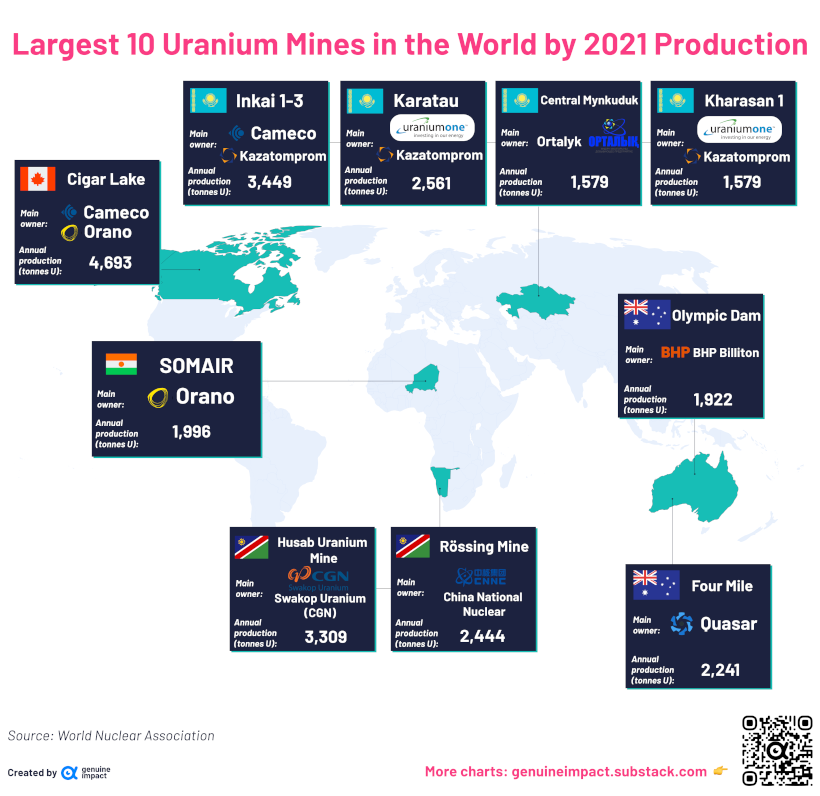
Of the largest mines in the world, four are found in Kazakhstan. Altogether, uranium mined in Kazakhstan accounted for 45% of the world’s uranium supply in 2021.
| Uranium Mine | Country | Main Owner | 2021 Production |
|---|---|---|---|
| Cigar Lake | 🇨🇦 Canada | Cameco/Orano | 4,693t |
| Inkai 1-3 | 🇰🇿 Kazakhstan | Kazaktomprom/Cameco | 3,449t |
| Husab | 🇳🇦 Namibia | Swakop Uranium (CGN) | 3,309t |
| Karatau (Budenovskoye 2) | 🇰🇿 Kazakhstan | Uranium One/Kazatomprom | 2,561t |
| Rössing | 🇳🇦 Namibia | CNNC | 2,444t |
| Four Mile | 🇦🇺 Australia | Quasar | 2,241t |
| SOMAIR | 🇳🇪 Niger | Orano | 1,996t |
| Olympic Dam | 🇦🇺 Australia | BHP Billiton | 1,922t |
| Central Mynkuduk | 🇰🇿 Kazakhstan | Ortalyk | 1,579t |
| Kharasan 1 | 🇰🇿 Kazakhstan | Kazatomprom/Uranium One | 1,579t |
Namibia, which has two of the five largest uranium mines in operation, is the second largest supplier of uranium by country, at 12%, followed by Canada at 10%.
Interestingly, the owners of these mines are not necessarily local. For example, France’s Orano operates mines in Canada and Niger. Russia’s Uranium One operates mines in Kazakhstan, the U.S., and Tanzania. China’s CGN owns mines in Namibia.
And despite the African continent holding a sizable amount of uranium reserves, no African company placed in the top 10 biggest companies by production. Sopamin from Niger was the highest ranked at #12 with 809 tonnes mined.
Uranium Mining and Nuclear Energy
Uranium mining has changed drastically since the first few nuclear power plants came online in the 1950s.
For 30 years, uranium production grew steadily due to both increasing demand for nuclear energy and expanding nuclear arsenals, eventually peaking at 69,692 tonnes mined in 1980 at the height of the Cold War.
Nuclear energy production (measured in terawatt-hours) also rose consistently until the 21st century, peaking in 2001 when it contributed nearly 7% to the world’s energy supply. But in the years following, it started to drop and flatline.
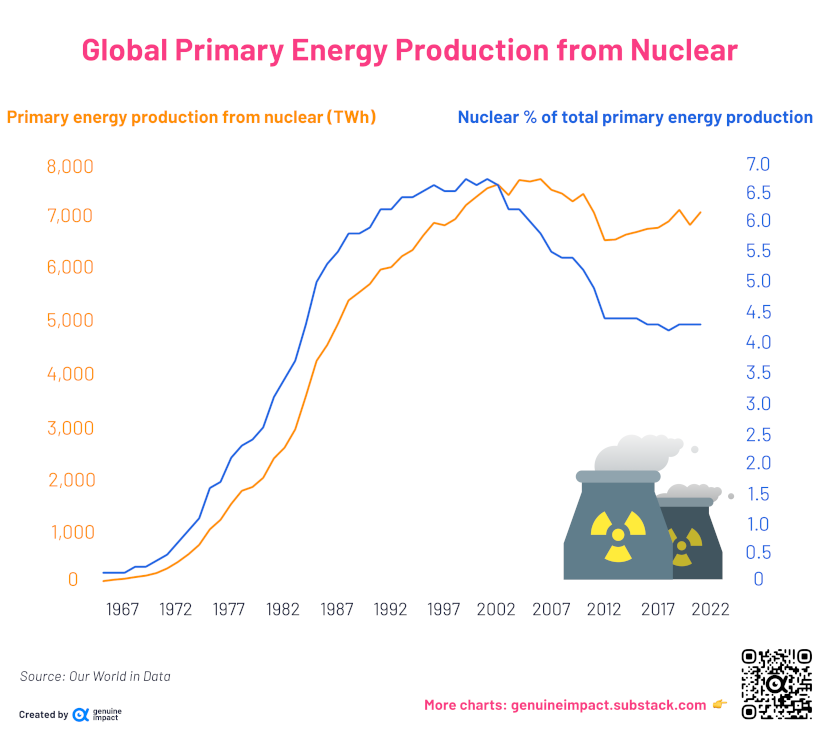
By 2021, nuclear energy had fallen to 4.3% of global energy production. Several nuclear accidents—Chernobyl, Three Mile Island, and Fukushima—contributed to turning sentiment against nuclear energy.
| Year | Nuclear Energy Production | % of Total Energy |
|---|---|---|
| 1965 | 72 TWh | 0.2% |
| 1966 | 98 TWh | 0.2% |
| 1967 | 116 TWh | 0.2% |
| 1968 | 148 TWh | 0.3% |
| 1969 | 175 TWh | 0.3% |
| 1970 | 224 TWh | 0.4% |
| 1971 | 311 TWh | 0.5% |
| 1972 | 432 TWh | 0.7% |
| 1973 | 579 TWh | 0.9% |
| 1974 | 756 TWh | 1.1% |
| 1975 | 1,049 TWh | 1.6% |
| 1976 | 1,228 TWh | 1.7% |
| 1977 | 1,528 TWh | 2.1% |
| 1978 | 1,776 TWh | 2.3% |
| 1979 | 1,847 TWh | 2.4% |
| 1980 | 2,020 TWh | 2.6% |
| 1981 | 2,386 TWh | 3.1% |
| 1982 | 2,588 TWh | 3.4% |
| 1983 | 2,933 TWh | 3.7% |
| 1984 | 3,560 TWh | 4.3% |
| 1985 | 4,225 TWh | 5% |
| 1986 | 4,525 TWh | 5.3% |
| 1987 | 4,922 TWh | 5.5% |
| 1988 | 5,366 TWh | 5.8% |
| 1989 | 5,519 TWh | 5.8% |
| 1990 | 5,676 TWh | 5.9% |
| 1991 | 5,948 TWh | 6.2% |
| 1992 | 5,993 TWh | 6.2% |
| 1993 | 6,199 TWh | 6.4% |
| 1994 | 6,316 TWh | 6.4% |
| 1995 | 6,590 TWh | 6.5% |
| 1996 | 6,829 TWh | 6.6% |
| 1997 | 6,782 TWh | 6.5% |
| 1998 | 6,899 TWh | 6.5% |
| 1999 | 7,162 TWh | 6.7% |
| 2000 | 7,323 TWh | 6.6% |
| 2001 | 7,481 TWh | 6.7% |
| 2002 | 7,552 TWh | 6.6% |
| 2003 | 7,351 TWh | 6.2% |
| 2004 | 7,636 TWh | 6.2% |
| 2005 | 7,608 TWh | 6% |
| 2006 | 7,654 TWh | 5.8% |
| 2007 | 7,452 TWh | 5.5% |
| 2008 | 7,382 TWh | 5.4% |
| 2009 | 7,233 TWh | 5.4% |
| 2010 | 7,374 TWh | 5.2% |
| 2011 | 7,022 TWh | 4.9% |
| 2012 | 6,501 TWh | 4.4% |
| 2013 | 6,513 TWh | 4.4% |
| 2014 | 6,607 TWh | 4.4% |
| 2015 | 6,656 TWh | 4.4% |
| 2016 | 6,715 TWh | 4.3% |
| 2017 | 6,735 TWh | 4.3% |
| 2018 | 6,856 TWh | 4.2% |
| 2019 | 7,073 TWh | 4.3% |
| 2020 | 6,789 TWh | 4.3% |
| 2021 | 7,031 TWh | 4.3% |
More recently, a return to nuclear energy has gained some support as countries push for transitions to cleaner energy, since nuclear power generates no direct carbon emissions.
What’s Next for Nuclear Energy?
Nuclear remains one of the least harmful sources of energy, and some countries are pursuing advancements in nuclear tech to fight climate change.
Small, modular nuclear reactors are one of the current proposed solutions to both bring down costs and reduce construction time of nuclear power plants. The benefits include smaller capital investments and location flexibility by trading off energy generation capacity.
With countries having to deal with aging nuclear reactors and climate change at the same time, replacements need to be considered. Will they come in the form of new nuclear power and uranium mining, or alternative sources of energy?

This article was published as a part of Visual Capitalist's Creator Program, which features data-driven visuals from some of our favorite Creators around the world.
Crime
Mapped: The Safest Cities in the U.S.
How safe is small town America? This map reveals the safest cities in the U.S. in terms of the total crime rate per every 1,000 residents.
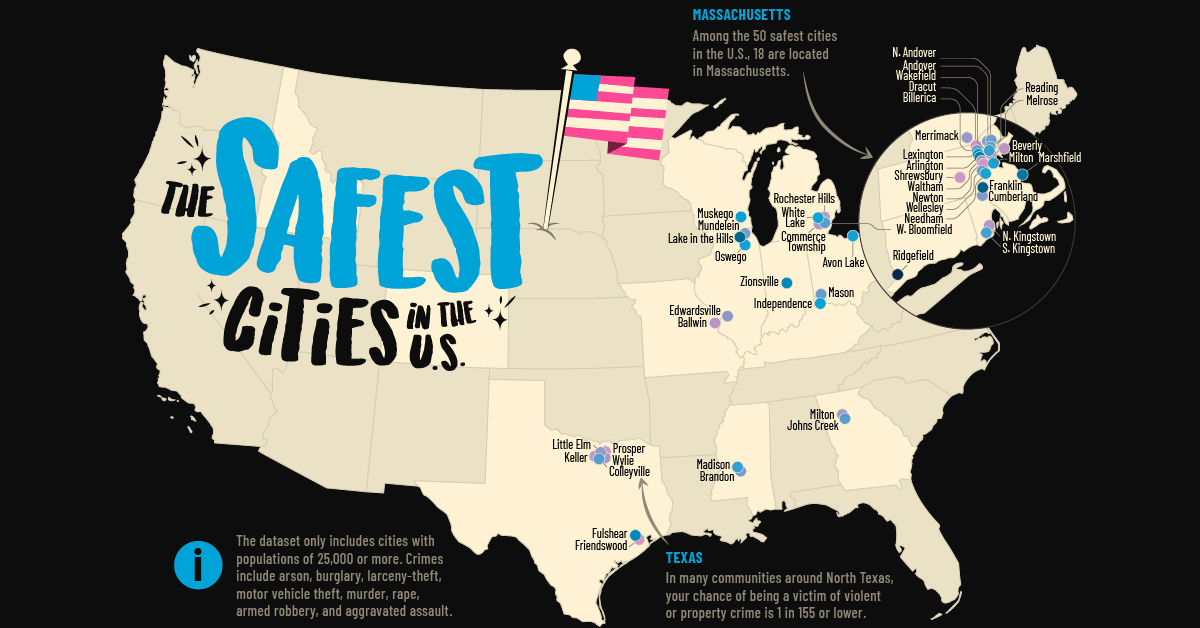
Mapped: The Safest Cities in America
The phrase “small town America” often conjures up images of white picket fences, well-trimmed lawns, and big houses. But how safe is modern-day suburbia in America?
Some of the smallest places in the country can actually be among the most dangerous. Take for example Bessemer, Alabama, with a population of around 26,000 and a violent crime rate of 33.1 per every 1,000 residents.
That said, there are many small cities that are true havens for families across the United States. This map showcases the safest cities in the U.S., using FBI data and Census Bureau populations compiled by NeighborhoodScout in 2023.
Note: The source only considered cities with a population of 25,000 or higher. This report is based on total index crimes reported in each city, which includes arson, burglary, larceny-theft, motor vehicle theft, murder, rape, armed robbery, and aggravated assault.
Top 100 Safest Cities in the U.S.
40% of the cities in the ranking are located in Northeastern states, which are typically rated the “safest” based on FBI data.
Here’s a closer look at the full list:
| Rank | City | State | Total Crime Rate(per 1,000 residents) | Chance of Beinga Victim |
|---|---|---|---|---|
| 1 | Ridgefield | Connecticut | 1.9 | 1 in 510 |
| 2 | Franklin | Massachusetts | 2.9 | 1 in 344 |
| 3 | Lake in the Hills | Illinois | 3.1 | 1 in 321 |
| 4 | Marshfield | Massachusetts | 3.3 | 1 in 300 |
| 5 | Arlington | Massachusetts | 3.4 | 1 in 292 |
| 6 | Fulshear | Texas | 3.6 | 1 in 276 |
| 7 | Zionsville | Indiana | 3.6 | 1 in 275 |
| 8 | Lexington | Massachusetts | 3.7 | 1 in 270 |
| 9 | Muskego | Wisconsin | 3.8 | 1 in 265 |
| 10 | Rexburg | Idaho | 3.9 | 1 in 253 |
| 11 | Independence | Kentucky | 3.9 | 1 in 253 |
| 12 | Oswego | Illinois | 4.1 | 1 in 238 |
| 13 | Milton | Massachusetts | 4.2 | 1 in 233 |
| 14 | Needham | Massachusetts | 4.2 | 1 in 233 |
| 15 | White Lake | Michigan | 4.2 | 1 in 233 |
| 16 | Avon Lake | Ohio | 4.3 | 1 in 232 |
| 17 | Madison | Mississippi | 4.5 | 1 in 221 |
| 18 | Wakefield | Massachusetts | 4.5 | 1 in 218 |
| 19 | Windsor | Colorado | 4.5 | 1 in 218 |
| 20 | South Kingstown | Rhode Island | 4.7 | 1 in 212 |
| 21 | Colleyville | Texas | 4.8 | 1 in 206 |
| 22 | West Bloomfield | Michigan | 4.9 | 1 in 204 |
| 23 | Johns Creek | Georgia | 4.9 | 1 in 202 |
| 24 | Billerica | Massachusetts | 5.1 | 1 in 195 |
| 25 | Mason | Ohio | 5.1 | 1 in 192 |
| 26 | Reading | Massachusetts | 5.1 | 1 in 192 |
| 27 | North Andover | Massachusetts | 5.2 | 1 in 190 |
| 28 | Wellesley | Massachusetts | 5.2 | 1 in 189 |
| 29 | Mundelein | Illinois | 5.3 | 1 in 187 |
| 30 | Brandon | Mississippi | 5.3 | 1 in 186 |
| 31 | Cumberland | Rhode Island | 5.4 | 1 in 184 |
| 32 | Andover | Massachusetts | 5.4 | 1 in 182 |
| 33 | Edwardsville | Illinois | 5.5 | 1 in 178 |
| 34 | Little Elm | Texas | 5.6 | 1 in 176 |
| 35 | Merrimack | New Hampshire | 5.7 | 1 in 172 |
| 36 | Waltham | Massachusetts | 5.8 | 1 in 169 |
| 37 | Wylie | Texas | 5.9 | 1 in 169 |
| 38 | Commerce Township | Michigan | 5.9 | 1 in 169 |
| 39 | Milton | Georgia | 5.9 | 1 in 167 |
| 40 | Melrose | Massachusetts | 6.0 | 1 in 164 |
| 41 | Ballwin | Missouri | 6.1 | 1 in 162 |
| 42 | North Kingstown | Rhode Island | 6.1 | 1 in 162 |
| 43 | Beverly | Massachusetts | 6.2 | 1 in 161 |
| 44 | Rochester Hills | Michigan | 6.2 | 1 in 160 |
| 45 | Keller | Texas | 6.3 | 1 in 158 |
| 46 | Shrewsbury | Massachusetts | 6.4 | 1 in 156 |
| 47 | Dracut | Massachusetts | 6.4 | 1 in 155 |
| 48 | Prosper | Texas | 6.4 | 1 in 155 |
| 49 | Newton | Massachusetts | 6.5 | 1 in 152 |
| 50 | Friendswood | Texas | 6.5 | 1 in 152 |
| 51 | McHenry | Illinois | 6.5 | 1 in 152 |
| 52 | Fort Mill | South Carolina | 6.6 | 1 in 151 |
| 53 | Wallingford | Connecticut | 6.8 | 1 in 146 |
| 54 | Caledonia | Wisconsin | 6.9 | 1 in 144 |
| 55 | Belmont | Massachusetts | 6.9 | 1 in 144 |
| 56 | De Pere | Wisconsin | 6.9 | 1 in 143 |
| 57 | Flower Mound | Texas | 7.0 | 1 in 142 |
| 58 | Easton | Massachusetts | 7.0 | 1 in 141 |
| 59 | Highland Park | Illinois | 7.0 | 1 in 141 |
| 60 | Carmel | Indiana | 7.2 | 1 in 138 |
| 61 | Sachse | Texas | 7.2 | 1 in 138 |
| 62 | Algonquin | Illinois | 7.2 | 1 in 137 |
| 63 | Hendersonville | Tennessee | 7.2 | 1 in 137 |
| 64 | San Luis | Arizona | 7.3 | 1 in 136 |
| 65 | Fishers | Indiana | 7.3 | 1 in 135 |
| 66 | Perrysburg | Ohio | 7.4 | 1 in 135 |
| 67 | Lake Stevens | Washington | 7.4 | 1 in 134 |
| 68 | Cheshire | Connecticut | 7.4 | 1 in 134 |
| 69 | Milford | Massachusetts | 7.5 | 1 in 132 |
| 70 | Saratoga Springs | Utah | 7.5 | 1 in 132 |
| 71 | Bella Vista | Arkansas | 7.5 | 1 in 132 |
| 72 | Princeton | New Jersey | 7.5 | 1 in 131 |
| 73 | Bluffton | South Carolina | 7.6 | 1 in 130 |
| 74 | Novi | Michigan | 7.6 | 1 in 130 |
| 75 | Chelmsford | Massachusetts | 7.6 | 1 in 130 |
| 76 | Amherst | Massachusetts | 7.7 | 1 in 129 |
| 77 | Rosemount | Minnesota | 7.7 | 1 in 129 |
| 78 | Gloucester | Massachusetts | 7.7 | 1 in 129 |
| 79 | Syracuse | Utah | 7.8 | 1 in 127 |
| 80 | Waukee | Iowa | 7.8 | 1 in 126 |
| 81 | Mequon | Wisconsin | 7.9 | 1 in 126 |
| 82 | Westfield | Indiana | 7.9 | 1 in 126 |
| 83 | Spring Hill | Tennessee | 7.9 | 1 in 126 |
| 84 | Upper Arlington | Ohio | 7.9 | 1 in 126 |
| 85 | Rahway | New Jersey | 7.9 | 1 in 125 |
| 86 | Montclair | New Jersey | 7.9 | 1 in 125 |
| 87 | Greenwich | Connecticut | 8.0 | 1 in 125 |
| 88 | Hutto | Texas | 8.0 | 1 in 124 |
| 89 | Vestavia Hills | Alabama | 8.0 | 1 in 123 |
| 90 | Brownsburg | Indiana | 8.1 | 1 in 123 |
| 91 | Wilmette | Illinois | 8.1 | 1 in 123 |
| 92 | New Milford | Connecticut | 8.1 | 1 in 122 |
| 93 | Hilliard | Ohio | 8.2 | 1 in 120 |
| 94 | Royal Oak | Michigan | 8.2 | 1 in 120 |
| 95 | Derry | New Hampshire | 8.3 | 1 in 121 |
| 96 | Dublin | Ohio | 8.3 | 1 in 120 |
| 97 | West Warwick | Rhode Island | 8.5 | 1 in 116 |
| 98 | Watertown | Massachusetts | 8.5 | 1 in 116 |
| 99 | Walpole | Massachusetts | 8.6 | 1 in 115 |
| 100 | Kaysville | Utah | 8.6 | 1 in 115 |
One quarter of the safest cities are located in Massachusetts, with the vast majority clustered around Boston.
The median population of the cities and towns in the top 100 is just 32,000, and few widely-recognized cities make the list. Carmel, Indiana (#60) is the only city with a population above 100,000 to make the rankings. This would seem to follow the logic that bigger cities are more dangerous, but our map covering the most dangerous cities in America shows that many small cities were just as dangerous, and some even more.
Regardless, small towns can truly be idyllic. For example, a person’s chance of falling victim to crime in Ridgefield, Connecticut, the safest ranked city in the U.S., is just 1-in-510. That’s an overall rate of fewer than two incidents of crime per every 1,000 residents.
One surprising observation from the data is that many of the safest U.S. cities are in very close proximity to some of the most dangerous.
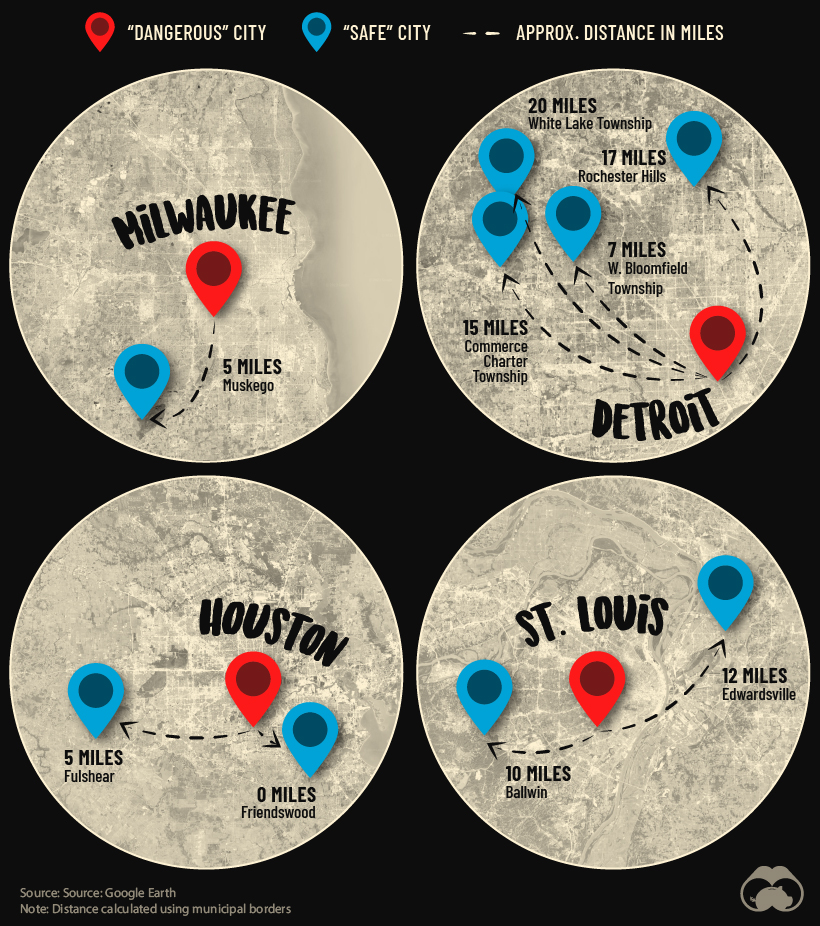
One example that illustrates this is Detroit, which ranks as the sixth most dangerous city in America. Despite this, as shown on the map above, there are four communities nearby that have some of the lowest crime rates in America.
In other words, America’s metro areas contain much contrast, and these insights provide valuable information for individuals and families seeking secure places to live across the country.
-

 Energy2 weeks ago
Energy2 weeks agoWho’s Still Buying Russian Fossil Fuels in 2023?
-

 VC+4 days ago
VC+4 days agoWhat’s New on VC+ in July
-

 Investor Education4 weeks ago
Investor Education4 weeks agoVisualizing BlackRock’s Top Equity Holdings
-

 Technology2 weeks ago
Technology2 weeks agoMeet the Competing Apps Battling for Twitter’s Market Share
-

 Public Opinion17 hours ago
Public Opinion17 hours agoHow Do Chinese Citizens Feel About Other Countries?
-

 Markets4 weeks ago
Markets4 weeks agoVisualizing Every Company on the S&P 500 Index
-

 Markets2 weeks ago
Markets2 weeks agoVisualizing 1 Billion Square Feet of Empty Office Space
-
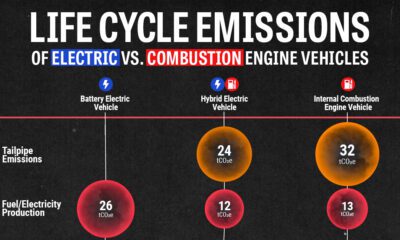
 Energy4 weeks ago
Energy4 weeks agoLife Cycle Emissions: EVs vs. Combustion Engine Vehicles



